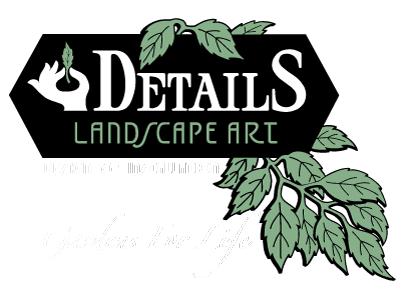The valve manifold is a key component of the irrigation system. Almost every project installed by Details Landscape Art requires irrigation, and usually the valve manifold calls for multiple valves. Drip irrigation  requires a different valve than lawns, and when the lawn is large, more than one valve will be needed. And if some of the plant material is in the sun and some in the shade, multiple drip valves make it easier to irrigate these plants according to their specific watering needs.
requires a different valve than lawns, and when the lawn is large, more than one valve will be needed. And if some of the plant material is in the sun and some in the shade, multiple drip valves make it easier to irrigate these plants according to their specific watering needs.
Before starting, we must point out the difference between Schedule 40 pipe and fittings (white) and Schedule 80 pipe and fittings (gray). Schedule 40 is appropriate for underground applications  – it is easily sun damaged over time. It is typically used for lawn sprinklers and other underground irrigation connections. Schedule 80 is treated as to be resistant to sun damage, and therefore the correct choice for above ground installations, such as the above ground water connections for our valve manifold. We will assume for purposes of illustration that all pipe and fittings will be ¾”. Teflon tape will be used for all threaded connections.
– it is easily sun damaged over time. It is typically used for lawn sprinklers and other underground irrigation connections. Schedule 80 is treated as to be resistant to sun damage, and therefore the correct choice for above ground installations, such as the above ground water connections for our valve manifold. We will assume for purposes of illustration that all pipe and fittings will be ¾”. Teflon tape will be used for all threaded connections.
The first step in installing the valve manifold is deciding on its location. We usually try tie in to an existing hose bibb as the water source. The valves need to be in an area that’s accessible, yet not too close to a plant that might hide it, or another garden element that it might interfere with. It would also be nice if it were out of sight.
If we have found a convenient hose bibb to connect to, a rectangular hole is dug to one side of the hose bibb to a depth of 8-10”. The first step is to turn off the water at either a nearby gate or ball valve, or at the property’s water meter. Certainly we need to advise the homeowner that the water supply to the house will be temporarily shut off. We then carefully remove the hose bibb, using wrenches on the line coming out of the house as well as the hose bibb. There is nothing worse than breaking the water line inside the exterior of the home.
With the hose bibb removed, there should be an exposed end of the pipe from which the hose bibb was removed with male (exterior) pipe threads (if the end has female threads, a short nipple will be used to transition). We then attach a Sch. 80 female threaded tee (three sided). One side of the longer side of the tee is threaded onto the male threads from which the hose bibb was removed. It is threaded so that the short side points down. An 18” Sch. 80 nipple is threaded into this female threaded side of the tee and should extend 6-8” below grade. This nipple may be cut a little above center and a brass ball valve inserted using Sch. 80 male adapters. The hose bibb is then threaded on the outside end of the tee. And the water to the house may be turned back on.
Now that we are below grade we can use Sch. 40 pipe and fittings. A slip elbow is glued onto the Sch. 80 nipple, and a 6” piece of pipe is glued so that runs parallel to the house. Then a Sch. 40 tee is glued onto the end of that 6” piece of pipe with the short side of the tee vertical. A Sch. 80 nipple will extend verticals from this tee, and the first valve will be threaded onto the top of this nipple. Another 6” pipe will extend horizontally from the Sch. 40 tee out in the same direction as the first piece of pipe. Then another tee, another 18” Sch. 80 nipple with a second valve threaded on top. And so on, for however many valves are required. At the end of the manifold we like to use a last tee with a last piece of 6” pipe with a cap glued on just in case the owner wants to add another valve later. The hole may now be filled.
And voila! We have installed a valve manifold.
